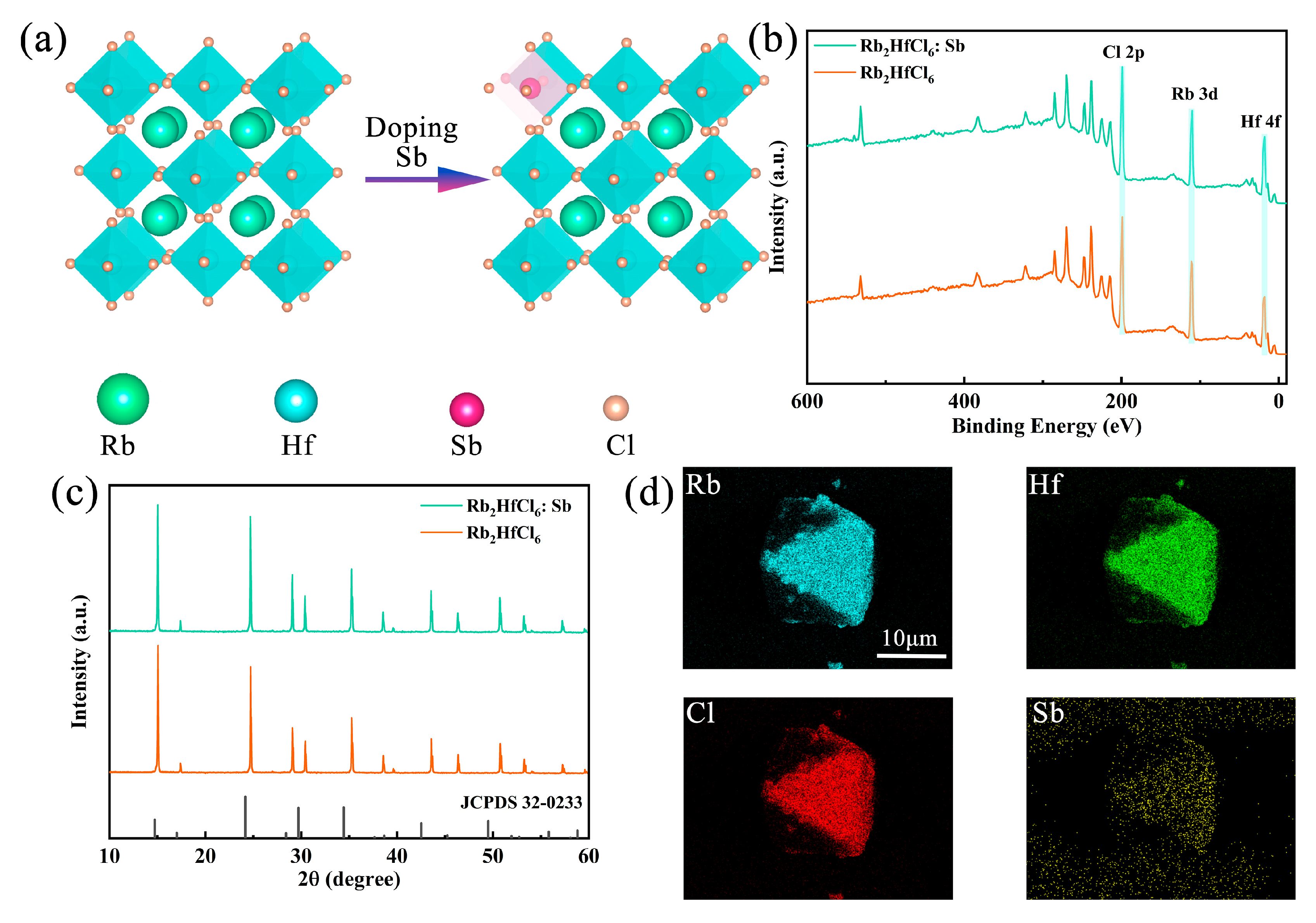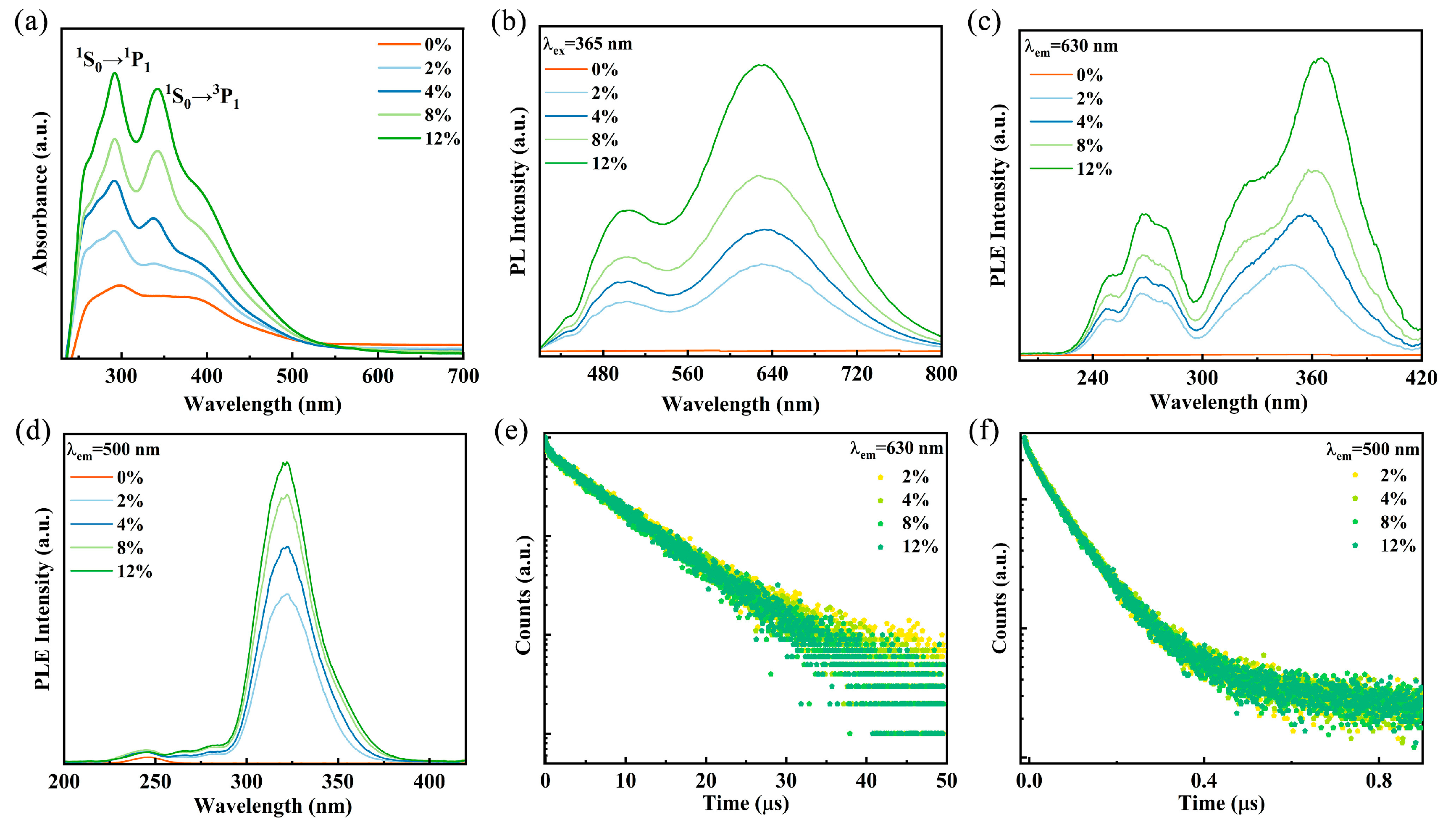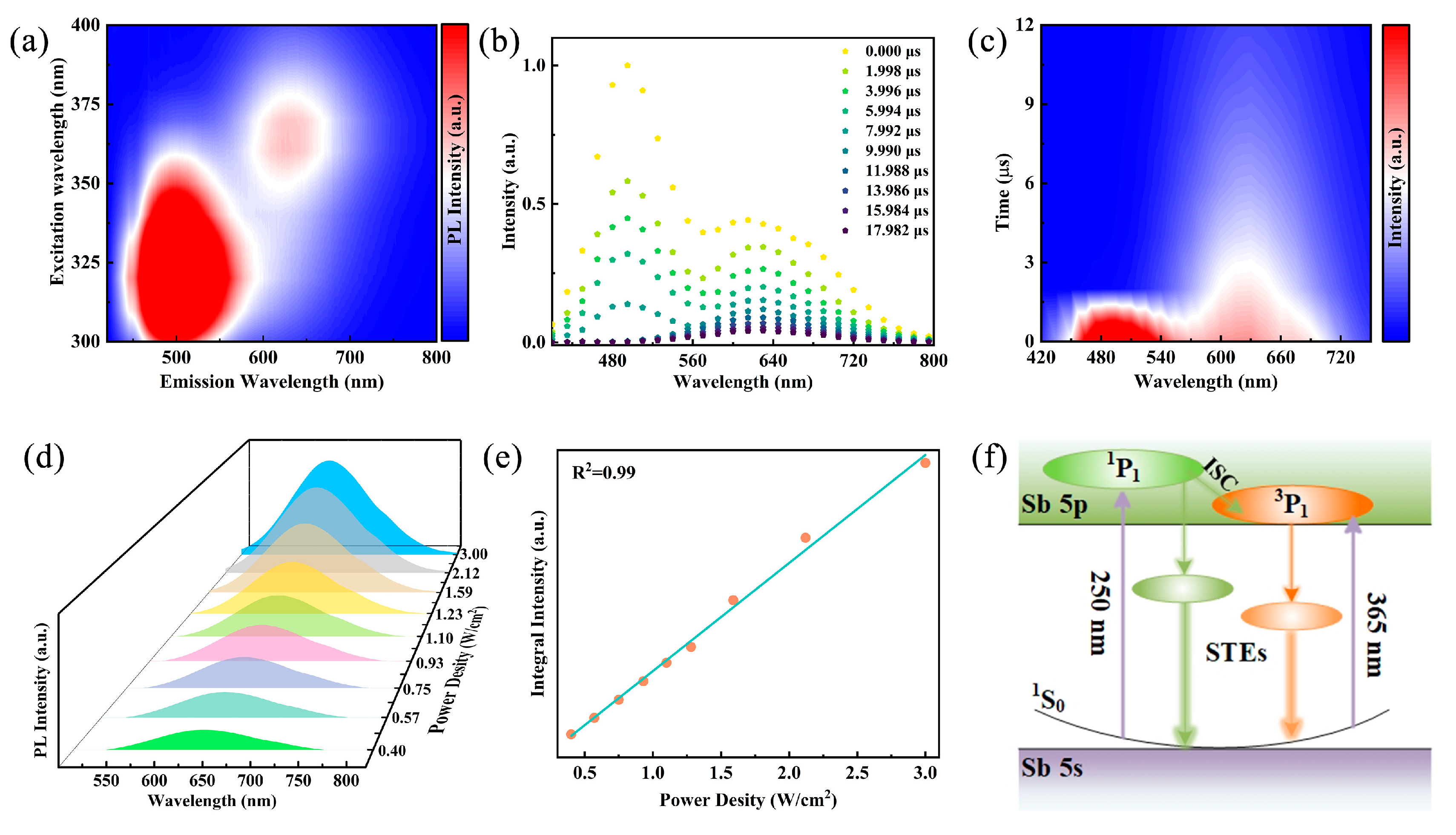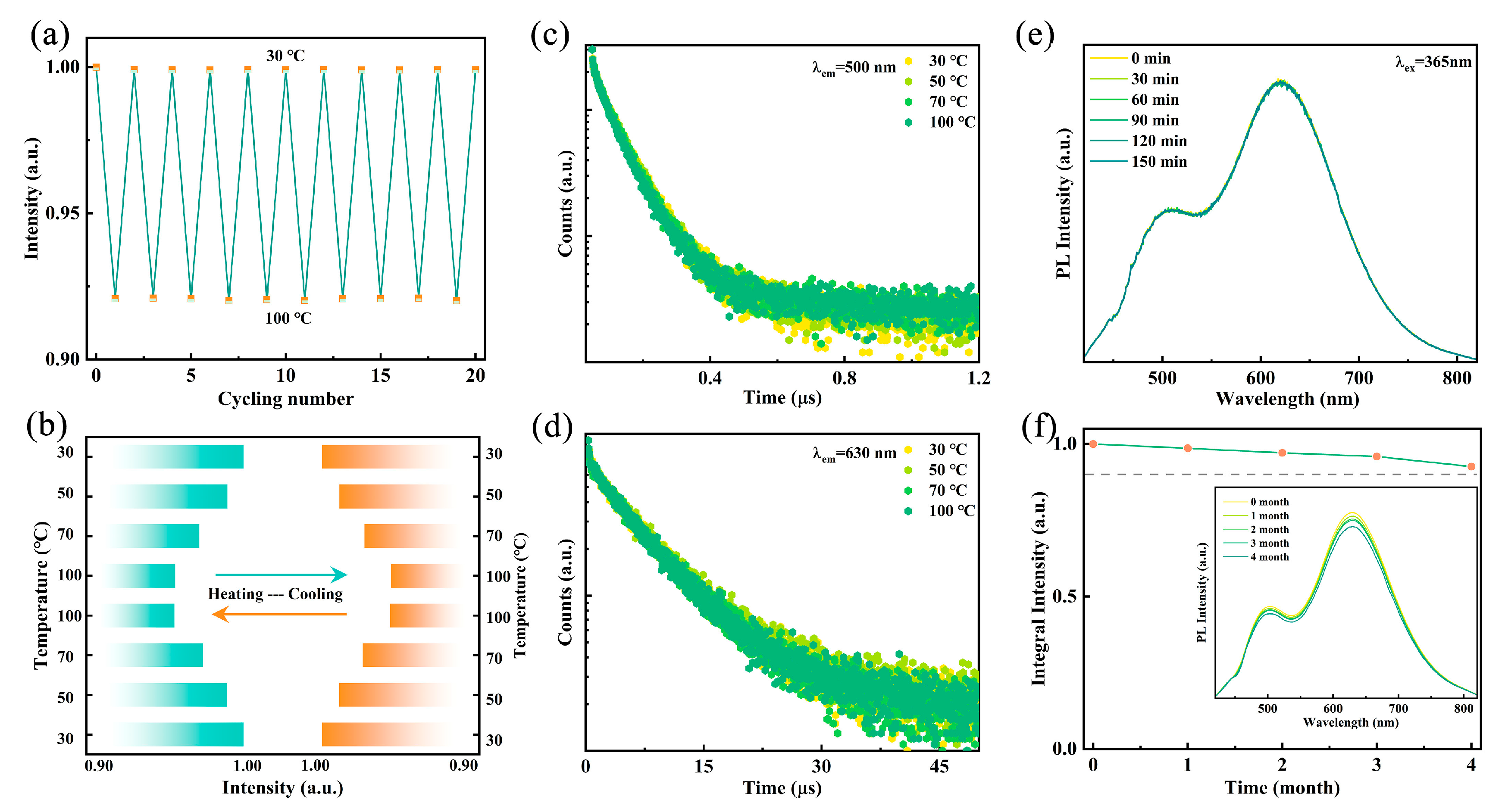Sb3+-Doped Rb2HfCl6 Perovskites as High-Performance Thermally Stable Single-Component Phosphors for White Light-Emitting Diodes
Abstract
:1. Introduction
2. Experimental Section
3. Results and Discussion
4. Conclusions
Supplementary Materials
Author Contributions
Funding
Institutional Review Board Statement
Informed Consent Statement
Data Availability Statement
Conflicts of Interest
References
- Nair, G.B.; Swart, H.C.; Dhoble, S.J. A Review on the Advancements in Phosphor-Converted Light Emitting Diodes (Pc-LEDs): Phosphor Synthesis, Device Fabrication and Characterization. Prog. Mater. Sci. 2020, 109, 100622. [Google Scholar] [CrossRef]
- Cho, J.; Park, J.H.; Kim, J.K.; Schubert, E.F. White Light-emitting Diodes: History, Progress, and Future. Laser Photonics Rev. 2017, 11, 1600147. [Google Scholar] [CrossRef]
- Shen, C.; Yang, Y.; Jin, S.; Ming, J.; Feng, H.; Xu, Z. White Light-Emitting Diodes Using Blue and Yellow–Orange-Emitting Phosphors. Optik 2010, 121, 1487–1491. [Google Scholar] [CrossRef]
- Bui, D.A.; Hauser, P.C. Analytical Devices Based on Light-Emitting Diodes—A Review of the State-of-the-Art. Anal. Chim. Acta 2015, 853, 46–58. [Google Scholar] [CrossRef]
- Zhang, H.; Zhang, H.; Pan, A.; Yang, B.; He, L.; Wu, Y. Rare Earth-Free Luminescent Materials for WLEDs: Recent Progress and Perspectives. Adv. Mater. Technol. 2021, 6, 2000648. [Google Scholar] [CrossRef]
- Pan, M.; Liao, W.-M.; Yin, S.-Y.; Sun, S.-S.; Su, C.-Y. Single-Phase White-Light-Emitting and Photoluminescent Color-Tuning Coordination Assemblies. Chem. Rev. 2018, 118, 8889–8935. [Google Scholar] [CrossRef]
- Tsai, M.-Y.; Tang, C.-Y.; Wang, C.H.; Tsai, Y.Y.; Chen, C.-H. Investigation on Some Parameters Affecting Optical Degradation of LED Packages During High-Temperature Aging. IEEE Trans. Device Mater. Reliab. 2015, 15, 335–341. [Google Scholar] [CrossRef]
- Caria, A.; Fraccaroli, R.; Pierobon, G.; Castellaro, T.; Mura, G.; Ricci, P.C.; De Santi, C.; Buffolo, M.; Trivellin, N.; Zanoni, E.; et al. Early Failure of High-Power White LEDs for Outdoor Applications under Extreme Electrical Stress: Role of Silicone Encapsulant. Microelectron. Reliab. 2023, 150, 115142. [Google Scholar] [CrossRef]
- Sun, R.; Zhou, D.; Ding, Y.; Wang, Y.; Wang, Y.; Zhuang, X.; Liu, S.; Ding, N.; Wang, T.; Xu, W.; et al. Efficient Single-Component White Light Emitting Diodes Enabled by Lanthanide Ions Doped Lead Halide Perovskites via Controlling Förster Energy Transfer and Specific Defect Clearance. Light Sci. Appl. 2022, 11, 340. [Google Scholar] [CrossRef]
- Protesescu, L.; Yakunin, S.; Bodnarchuk, M.I.; Krieg, F.; Caputo, R.; Hendon, C.H.; Yang, R.X.; Walsh, A.; Kovalenko, M.V. Nanocrystals of Cesium Lead Halide Perovskites (CsPbX3, X = Cl, Br, and I): Novel Optoelectronic Materials Showing Bright Emission with Wide Color Gamut. Nano Lett. 2015, 15, 3692–3696. [Google Scholar] [CrossRef]
- Sabbar, A.; Madhusoodhanan, S.; Al-Kabi, S.; Dong, B.; Wang, J.; Atcitty, S.; Kaplar, R.; Ding, D.; Mantooth, A.; Yu, S.-Q.; et al. High Temperature and Power Dependent Photoluminescence Analysis on Commercial Lighting and Display LED Materials for Future Power Electronic Modules. Sci. Rep. 2019, 9, 16758. [Google Scholar] [CrossRef] [PubMed]
- Liu, Z.; Ji, X.; Ma, Z.; Zhang, F.; Qi, X.; Chen, X.; Wu, D.; Liu, Y.; Jia, M.; Li, X.; et al. Healthy and High-Quality Single-Source Lighting Based on Double-Doped Tin Halide Engineering. Laser Photonics Rev. 2023, 17, 2300094. [Google Scholar]
- Chen, Q.; Lun, Z.; Chen, D.; Sun, Y.; Xiong, P.; Li, S.; Xu, S.; Yang, Z. A Novel Extra-Broadband Visible-Emitting Garnet Phosphor for Efficient Single-Component Pc-WLEDs. Inorg. Chem. Front. 2024, 11, 8547–8554. [Google Scholar] [CrossRef]
- Li, T.; Li, Q.; Tang, X.; Chen, Z.; Li, Y.; Zhao, H.; Wang, S.; Ding, X.; Zhang, Y.; Yao, J. Environment-Friendly Antisolvent Tert-Amyl Alcohol Modified Hybrid Perovskite Photodetector with High Responsivity. Photon. Res. 2021, 9, 781. [Google Scholar]
- Liu, Y.; Ma, Z.; Zhang, J.; He, Y.; Dai, J.; Li, X.; Shi, Z.; Manna, L. Light-Emitting Diodes Based on Metal Halide Perovskite and Perovskite Related Nanocrystals. Adv. Mater. 2025, 2415606. [Google Scholar] [CrossRef]
- Bi, C.; Yao, Z.; Sun, X.; Wei, X.; Wang, J.; Tian, J. Perovskite Quantum Dots with Ultralow Trap Density by Acid Etching-Driven Ligand Exchange for High Luminance and Stable Pure-Blue Light-Emitting Diodes. Adv. Mater. 2021, 33, 2006722. [Google Scholar]
- Zhou, J.; Luo, J.; Rong, X.; Wei, P.; Molokeev, M.S.; Huang, Y.; Zhao, J.; Liu, Q.; Zhang, X.; Tang, J.; et al. Lead-Free Perovskite Derivative Cs2SnCl6−xBrx Single Crystals for Narrowband Photodetectors. Adv. Opt. Mater. 2019, 7, 1900139. [Google Scholar] [CrossRef]
- Tan, Z.; Chu, Y.; Chen, J.; Li, J.; Ji, G.; Niu, G.; Gao, L.; Xiao, Z.; Tang, J. Lead-Free Perovskite Variant Solid Solutions Cs2Sn1-xTexCl6: Bright Luminescence and High Anti-Water Stability. Adv. Mater. 2020, 32, 2002443. [Google Scholar]
- Bryan, P.S.; Ferranti, S.A. Luminescence of Cs2ZrCl6 and Cs2HfCl6. J. Lumin. 1984, 31–32, 117–119. [Google Scholar] [CrossRef]
- Zhang, F.; Yang, D.; Shi, Z.; Qin, C.; Cui, M.; Ma, Z.; Wang, L.; Wang, M.; Ji, X.; Chen, X.; et al. Stable Zero-Dimensional Cesium Indium Bromide Hollow Nanocrystals Emitting Blue Light from Self-Trapped Excitons. Nano Today 2021, 38, 101153. [Google Scholar] [CrossRef]
- Morad, V.; Yakunin, S.; Benin, B.M.; Shynkarenko, Y.; Grotevent, M.J.; Shorubalko, I.; Boehme, S.C.; Kovalenko, M.V. Hybrid 0D Antimony Halides as Air-Stable Luminophores for High-Spatial-Resolution Remote Thermography. Adv. Mater. 2021, 33, 2007355. [Google Scholar] [CrossRef]
- Zhang, W.; Zheng, W.; Li, L.; Huang, P.; Gong, Z.; Zhou, Z.; Sun, J.; Yu, Y.; Chen, X. Dual-Band-Tunable White-Light Emission from Bi3+/Te4+ Emitters in Perovskite-Derivative Cs2SnCl6 Microcrystals. Angew. Chem. Int. Edit. 2022, 61, e202116085. [Google Scholar] [CrossRef] [PubMed]
- Jiang, F.; Wu, Z.; Lu, M.; Gao, Y.; Li, X.; Bai, X.; Ji, Y.; Zhang, Y. Broadband Emission Origin in Metal Halide Perovskites: Are Self-Trapped Excitons or Ions? Adv. Mater. 2023, 35, 2211088. [Google Scholar] [CrossRef] [PubMed]
- Arfin, H.; Kshirsagar, A.S.; Kaur, J.; Mondal, B.; Xia, Z.; Chakraborty, S.; Nag, A. Ns2Electron (Bi3+ and Sb3+) Doping in Lead-Free Metal Halide Perovskite Derivatives. Chem. Mater. 2020, 32, 10255–10267. [Google Scholar] [CrossRef]
- Zeng, R.; Bai, K.; Wei, Q.; Chang, T.; Yan, J.; Ke, B.; Huang, J.; Wang, L.; Zhou, W.; Cao, S.; et al. Boosting Triplet Self-Trapped Exciton Emission in Te(IV)-Doped Cs2SnCl6 Perovskite Variants. Nano Res. 2021, 14, 1551–1558. [Google Scholar] [CrossRef]
- Wang, C.; Li, Y.; Lv, Q.; Zheng, H.; Zhu, G.; Xu, X.; Wang, Y. Te4+/Bi3+ Co-Doped Double Perovskites with Tunable Dual-Emission for Contactless Light Sensor, Encrypted Information Transmission and White Light Emitting Diodes. Chem. Eng. J. 2022, 431, 134135. [Google Scholar] [CrossRef]
- Gong, S.; Wu, R.; Yang, S.; Wu, L.; Zhang, M.; Han, Q.; Wu, W. Tuning the Luminous Properties and Optical Thermometry of Cs2SnCl6 Phosphor Microcrystals via Bi and Sb Codoping. Photon. Res. 2021, 9, 2182. [Google Scholar] [CrossRef]
- Chang, J.; Wang, Y.; Li, Y.; Gao, Y.; Yu, H.; Cao, Y.; Zhang, X.; Chen, B.; Xu, S. Regulating A-Site Alloying of Te4+-Doped Hafnium-Halide Perovskite for Fluorescence Thermometry Achieving Breakthrough Sensitivity at High Temperatures. Laser Photonics Rev. 2025, 19, 2401620. [Google Scholar] [CrossRef]
- Chen, B.; Guo, Y.; Wang, Y.; Liu, Z.; Wei, Q.; Wang, S.; Rogach, A.L.; Xing, G.; Shi, P.; Wang, F. Multiexcitonic Emission in Zero-Dimensional Cs2ZrCl6:Sb3+ Perovskite Crystals. J. Am. Chem. Soc. 2021, 143, 17599–17606. [Google Scholar] [CrossRef]
- Liu, S.; Yang, B.; Chen, J.; Zheng, D.; Tang, Z.; Deng, W.; Han, K. Colloidal Synthesis and Tunable Multicolor Emission of Vacancy-Ordered Cs2HfCl6 Perovskite Nanocrystals. Laser Photonics Rev. 2022, 16, 2100439. [Google Scholar] [CrossRef]
- Liu, R.; Yang, J.; Zhao, D.; Liu, W.; Li, G.; Yan, W.; Zhang, W. Efficient Broadband Yellow-Green Emission of Vacancy Halide Double Perovskites Through the Ion-Exchanged Strategy. Inorg. Chem. 2021, 60, 17878–17888. [Google Scholar] [CrossRef]
- Jing, Y.; Liu, Y.; Li, M.; Xia, Z. Photoluminescence of Singlet/Triplet Self-Trapped Excitons in Sb3+-Based Metal Halides. Adv. Opt. Mater. 2021, 9, 2002213. [Google Scholar] [CrossRef]
- Oomen, E.W.J.L.; Smit, W.M.A.; Blasse, G. Jahn-Teller Effect in the Emission and Excitation Spectra of the Sb3+ Ion in LPO4 (L = Sc, Lu, Y). Phys. Rev. B 1988, 37, 18–26. [Google Scholar] [CrossRef]
- Li, S.; Luo, J.; Liu, J.; Tang, J. Self-Trapped Excitons in All-Inorganic Halide Perovskites: Fundamentals, Status, and Potential Applications. J. Phys. Chem. Lett. 2019, 10, 1999–2007. [Google Scholar] [CrossRef]
- Oomen, E.W.J.L.; Smit, W.M.A.; Blasse, G. On the Luminescence of Sb3+ in Cs2NaMCl6 (with M = Sc, Y, La): A Model System for the Study of Trivalent s2 Ions. J. Phys. C Solid State Phys. 1986, 19, 3263–3272. [Google Scholar] [CrossRef]
- Chang, J.; Xu, S.; Gao, Y.; Li, Y.; Wang, Y.; Yu, H.; Cao, Y.; Zhang, X.; Chen, B. Excitation Wavelength Regulated Dynamic Luminescence in Bi/Sb co-Doped Tin Halide for Encrypted Information Transmission and High-Sensitivity Wavelength Sensor. Adv. Mater. Technol. 2025, 10, 2401672. [Google Scholar] [CrossRef]
- Zhou, R.; Cheng, C.-A.; Wang, X.; Nie, K.; Wu, J.; Wu, M.; Duan, X.; Hu, Z.; Huq, I.U.; Wang, H.; et al. Metal Halide Perovskite Nanocrystals with Enhanced Photoluminescence and Stability toward Anti-Counterfeiting High-Performance Flexible Fibers. Nano Res. 2023, 16, 3542–3551. [Google Scholar] [CrossRef]
- Zhang, R.; Mao, X.; Yang, Y.; Yang, S.; Zhao, W.; Wumaier, T.; Wei, D.; Deng, W.; Han, K. Air-Stable, Lead-Free Zero-Dimensional Mixed Bismuth-Antimony Perovskite Single Crystals with Ultra-broadband Emission. Angew. Chem. Int. Edit. 2019, 58, 2725–2729. [Google Scholar] [CrossRef]
- Gray, M.B.; Hariyani, S.; Strom, T.A.; Majher, J.D.; Brgoch, J.; Woodward, P.M. High-Efficiency Blue Photoluminescence in the Cs2NaInCl6:Sb3+ Double Perovskite Phosphor. J. Mater. Chem. C 2020, 8, 6797–6803. [Google Scholar] [CrossRef]
- Benin, B.M.; Dirin, D.N.; Morad, V.; Wörle, M.; Yakunin, S.; Rainò, G.; Nazarenko, O.; Fischer, M.; Infante, I.; Kovalenko, M.V. Highly Emissive Self-Trapped Excitons in Fully Inorganic Zero-Dimensional Tin Halides. Angew. Chem. Int. Edit. 2018, 57, 11329–11333. [Google Scholar] [CrossRef]
- Xu, B.; Li, Y.; Hong, P.; Zhang, P.; Han, J.; Xiao, Z.; Quan, Z. Pressure-Controlled Free Exciton and Self-Trapped Exciton Emission in Quasi-One-Dimensional Hybrid Lead Bromides. Nat. Commun. 2024, 15, 7403. [Google Scholar] [CrossRef] [PubMed]
- Zhang, F.; Shi, Z.-F.; Ma, Z.-Z.; Li, Y.; Li, S.; Wu, D.; Xu, T.-T.; Li, X.-J.; Shan, C.-X.; Du, G.-T. Silica Coating Enhances the Stability of Inorganic Perovskite Nanocrystals for Efficient and Stable Down-Conversion in White Light-Emitting Devices. Nanoscale 2018, 10, 20131–20139. [Google Scholar] [CrossRef] [PubMed]
- Liu, X.; Xu, X.; Li, B.; Yang, L.; Li, Q.; Jiang, H.; Xu, D. Tunable Dual-Emission in Monodispersed Sb3+/Mn2+ Codoped Cs2NaInCl6 Perovskite Nanocrystals through an Energy Transfer Process. Small 2020, 16, 2002547. [Google Scholar] [CrossRef] [PubMed]
- Li, J.; Tan, Z.; Hu, M.; Chen, C.; Luo, J.; Li, S.; Gao, L.; Xiao, Z.; Niu, G.; Tang, J. Antimony Doped Cs2SnCl6 with Bright and Stable Emission. Front. Optoelectron. 2019, 12, 352–364. [Google Scholar] [CrossRef]
- Dai, G.; Ma, Z.; Qiu, Y.; Ma, Z. Codoped 2D All-Inorganic Halide Perovskite Cs3Cd2Cl7:Sb3+:Mn2+ with Ultralong Afterglow. Inorg. Chem. 2023, 62, 7906–7913. [Google Scholar] [CrossRef]
- Huang, D.; Zheng, P.; Cheng, Z.; Ouyang, Q.; Lian, H.; Lin, J. Metal Halides RbCdCl3:Sb3+ and Rb4CdCl6:Sb3+ with Yellow and Cyan Emissions Obtained via a Facile Hydrothermal Process. J. Mater. Chem. C 2023, 11, 16390–16397. [Google Scholar] [CrossRef]
- Zhang, W.; Chen, G.; Lu, X.; Wang, Y.; Zhang, N.; Zhang, Q.; Liu, X.; Tang, X. Unveiling Sb3+ Doping and Tricolor Luminescence from Intrinsic Self-Trapped Excitons in Cs2ZnCl4 Crystals. J. Phys. Chem. Lett. 2024, 15, 2616–2623. [Google Scholar] [CrossRef]





Disclaimer/Publisher’s Note: The statements, opinions and data contained in all publications are solely those of the individual author(s) and contributor(s) and not of MDPI and/or the editor(s). MDPI and/or the editor(s) disclaim responsibility for any injury to people or property resulting from any ideas, methods, instructions or products referred to in the content. |
© 2025 by the authors. Licensee MDPI, Basel, Switzerland. This article is an open access article distributed under the terms and conditions of the Creative Commons Attribution (CC BY) license (https://creativecommons.org/licenses/by/4.0/).
Share and Cite
Li, Y.; Gao, Y. Sb3+-Doped Rb2HfCl6 Perovskites as High-Performance Thermally Stable Single-Component Phosphors for White Light-Emitting Diodes. Materials 2025, 18, 1896. https://doi.org/10.3390/ma18091896
Li Y, Gao Y. Sb3+-Doped Rb2HfCl6 Perovskites as High-Performance Thermally Stable Single-Component Phosphors for White Light-Emitting Diodes. Materials. 2025; 18(9):1896. https://doi.org/10.3390/ma18091896
Chicago/Turabian StyleLi, Yanbiao, and Yuefeng Gao. 2025. "Sb3+-Doped Rb2HfCl6 Perovskites as High-Performance Thermally Stable Single-Component Phosphors for White Light-Emitting Diodes" Materials 18, no. 9: 1896. https://doi.org/10.3390/ma18091896
APA StyleLi, Y., & Gao, Y. (2025). Sb3+-Doped Rb2HfCl6 Perovskites as High-Performance Thermally Stable Single-Component Phosphors for White Light-Emitting Diodes. Materials, 18(9), 1896. https://doi.org/10.3390/ma18091896





